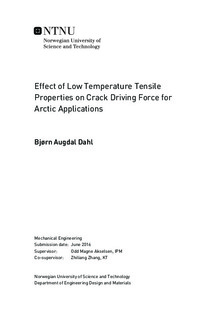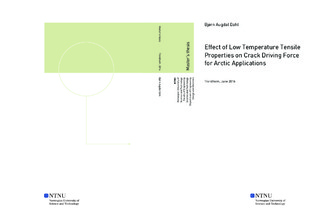| dc.description.abstract | Many petroleum companies expand their activities further north towards the Arctic region, resulting in design temperatures down to -60 °C, which is much lower than what is usual for most current petroleum installations. As properties of steels are temperature dependent, it is of great interest to evaluate the effects of low temperature on the crack driving force in steels. The present work investigates these effects numerically using finite element (FE) models of single-edge-notched-tension (SENT) specimens with crack depths 0.1 < a/W < 0.5. The effects of Lüders strain, yield strength and crack depth on the crack tip opening displacement (CTOD) and the relation between CTOD and crack mouth opening displacement (CMOD) are studied, and it is shown that an increase in yield strength and Lüders strain, as a result of Arctic temperature, intensifies the crack driving force. It is also shown that the crack depth has very little influence on the effect of Lüders strain on the CTOD. An approximate model that can be used to estimate the CTOD based on yield strength, Lüders strain and loading is proposed for gross stress levels σ_G/σ_y < 0.5 and a crack depth a/W = 0.5. It is finally shown that the tensile properties have a more significant effect on the CTOD-CMOD relation than the crack depth for a SENT specimen. | |

